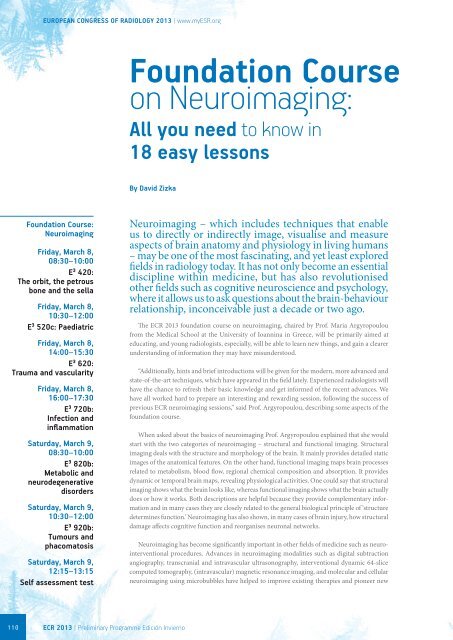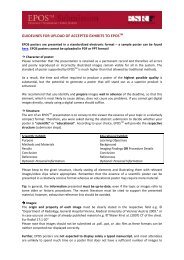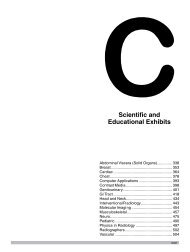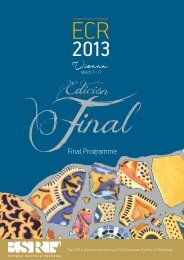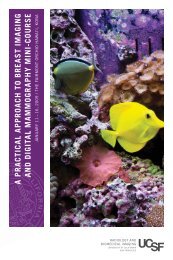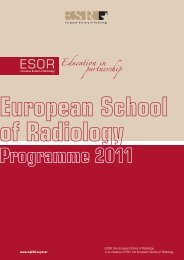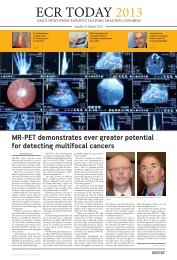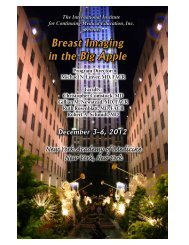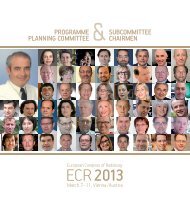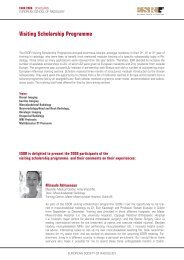EUROPEAN CONGRESS OF RADIOLOGY 2013 | www.<strong>myESR</strong>.<strong>org</strong>Foundation Courseon Neuroimaging:All you need to know in18 easy lessonsBy David ZizkaFoundation Course:NeuroimagingFriday, March 8,08:30–10:00E³ 420:The orbit, the petrousbone and the sellaFriday, March 8,10:30–12:00E³ 520c: PaediatricFriday, March 8,14:00–15:30E³ 620:Trauma and vascularityFriday, March 8,16:00–17:30E³ 720b:Infection andinflammationSaturday, March 9,08:30–10:00E³ 820b:Metabolic andneurodegenerativedisordersSaturday, March 9,10:30–12:00E³ 920b:Tumours andphacomatosisSaturday, March 9,12:15–13:15Self assessment testNeuroimaging – which includes techniques that enableus to directly or indirectly image, visualise and measureaspects of brain anatomy and physiology in living humans– may be one of the most fascinating, and yet least exploredfields in radiology today. It has not only become an essentialdiscipline within medicine, but has also revolutionisedother fields such as cognitive neuroscience and psychology,where it allows us to ask questions about the brain-behaviourrelationship, inconceivable just a decade or two ago.The ECR 2013 foundation course on neuroimaging, chaired by Prof. Maria Argyropouloufrom the Medical School at the University of Ioannina in Greece, will be primarily aimed ateducating, and young radiologists, especially, will be able to learn new things, and gain a clearerunderstanding of information they may have misunderstood.“Additionally, hints and brief introductions will be given for the modern, more advanced andstate-of-the-art techniques, which have appeared in the field lately. Experienced radiologists willhave the chance to refresh their basic knowledge and get informed of the recent advances. Wehave all worked hard to prepare an interesting and rewarding session, following the success ofprevious ECR neuroimaging sessions,” said Prof. Argyropoulou, describing some aspects of thefoundation course.When asked about the basics of neuroimaging Prof. Argyropoulou explained that she wouldstart with the two categories of neuroimaging – structural and functional imaging. Structuralimaging deals with the structure and morphology of the brain. It mainly provides detailed staticimages of the anatomical features. On the other hand, functional imaging maps brain processesrelated to metabolism, blood flow, regional chemical composition and absorption. It providesdynamic or temporal brain maps, revealing physiological activities. One could say that structuralimaging shows what the brain looks like, whereas functional imaging shows what the brain actuallydoes or how it works. Both descriptions are helpful because they provide complementary informationand in many cases they are closely related to the general biological principle of ‘structuredetermines function.’ Neuroimaging has also shown, in many cases of brain injury, how structuraldamage affects cognitive function and re<strong>org</strong>anises neuronal networks.Neuroimaging has become significantly important in other fields of medicine such as neurointerventionalprocedures. Advances in neuroimaging modalities such as digital subtractionangiography, transcranial and intravascular ultrasonography, interventional dynamic 64-slicecomputed tomography, (intravascular) magnetic resonance imaging, and molecular and cellularneuroimaging using microbubbles have helped to improve existing therapies and pioneer new110ECR 2013 | Preliminary Programme EdiciÓn Invierno
www.<strong>myESR</strong>.<strong>org</strong> | EUROPEAN CONGRESS OF RADIOLOGY 2013ones. Neuroimaging guides needles and catheters, providing safe paths for these instrumentsthrough the body to the diseased areas, minimising physical trauma to patients, reducing infectionrates and shortening recovery time and hospital stays.Neuroimaging is seen as having great potential in the early detection of debilitating braindiseases, even before common clinical symptoms occur.The foundation course onneuroimaging will be chaired byProf. Maria Argyropoulou from theMedical School at the University ofIoannina in Greece.“Alzheimer’s disease is an ideal example of the potential of neuroimaging in the early detectionof a common and devastating brain disease, before the occurrence of clinical symptoms,”explained Prof. Argyropoulou. The clinical diagnosis of Alzheimer’s disease is based on CSF markers,such as Aβ 1-42, t-tau and p-tau. However, these markers are not related to disease severityor progression. A variety of structural and functional MRI studies, and functional PET studieshave clearly shown anatomical, functional and molecular brain changes before significant cognitiveimpairment, during the presymptomatic and preclinical stages. Anatomical markers includehippocampal atrophy, ventricular volume, whole-brain atrophy and diffusion-MR markers in themedial temporal white matter (parahippocampus and posterior cingulum) and hippocampus.Functional markers have been produced mainly by resting-state fMRI and connectivity studies. Inaddition, β-amyloid deposits can be used as a molecular imaging marker as they are measured by11C-PiB PET uptake. All these early indications are extremely important for the fast and optimaltreatment of the disease. They may also indicate disease progression, but this has not yet beenproven conclusively. So far, there have been promising, but isolated research results. Hopefully,in the near future large scale multi-centre longitudinal studies such as the ‘Alzheimer’s DiseaseNeuroimaging Initiative’ will prove the clinical merit of these biomarkers and most importantlycome up with standardised tools and procedures in order to provide us with reliable neuroimagingprotocols and new validated diagnostic and prognostic criteria for the disease.The connection between neuroimaging and psychology remains a contentious topic amongexperts. Supporters of neuroimaging believe that there is some ‘systematic’ mapping from psychologicalfunction to brain function, which can be detected using neuroimaging. They believethat neuroimaging data can constrain cognitive theories in ways that cannot be addressed bybehavioural experiments alone, and therefore they can be used to distinguish between competingpsychological theories. Opponents argue that neuroimaging provides little evidence as to wherea cognitive process is performed and has little relevance to how it is performed. They argue thatneuroimaging provides descriptions of where, but not how the brain functions, an importantfactor for psychology.“I believe that the truth lies somewhere between these two opinions. With our current technologywe can detect brain activity, but in spatial and temporal scales which do not allow us to fullycomprehend the inner mechanisms that produce it. We have taken only the first, but importantsteps towards understanding the human brain. The burgeoning field of connectomics is based ona more realistic brain representation, where neuronal populations of complex networks of corticaland subcortical areas interact with each other by both excitatory and inhibitory mechanisms.It shows that neuroimaging, like any other scientific area, is constantly evolving and ultimatelyit will prove its merits, even to the more conservative cognitive psychologists,” suggested Prof.Argyropoulou, outlining a means of finding a balance between the different approaches.The foundation course on neuroimaging will consist of 18 lectures, giving an overview of allrelevant aspects and will conclude with a self-assessment test.Preliminary Programme EdiciÓn Invierno | ECR 2013111


